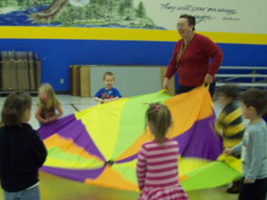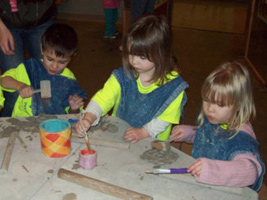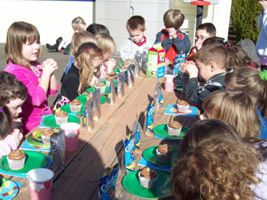The curriculum we use is a combination of High Scope, Play Way Method, and ChristLight.
We believe combining God's Word along with portions of the two academic and play curriculums provides balance for the whole child.
Social Skills
- Work and play cooperatively in variety of settings including large groups, small groups and learning centers.
- Exhibit behavior that demonstrates an understanding of school and classroom guidelines. i.e.: Routines, rules, schedules, and procedures.
- Listen to others while in large and small groups.
- Stay involved in self-selected activity for an appropriate length of time. (10-20 minutes)
- Follow simple verbal directions.
- Select and complete a task while working at a learning center.
- Make decisions and choices thru independent thought process.
- Attend to personal tasks. (Bathroom, hand washing, and clothing.)
- Realization of a world outside of self. Kindness, cooperation, and service to others as esteem builders.
Creative Skills
- Express thoughts and feelings about God, self, work, and play.
- Develop and verbalize solutions to simple problems. Conflict resolution.
- Think of new uses for familiar materials.
Language Arts
- Hear and repeat sounds in a sequence (hand rhymes, vocal sounds, numbers in a sequence, etc.)
- Hear and repeat sounds in a sequence (hand rhymes, vocal sounds, numbers in a sequence, etc.)
- Tell what happened first, middle, and last about an event or activity.
- Dictate a story about an event or experience.
- Answer questions and contribute ideas in a group conversation.
- Tell what is happening in a picture
- Identify and read first and last name in print.
- Identify and name eight basic colors (black, brown, red, yellow, orange, green, blue and purple).
- Begin to name and write the letters of the alphabet.
- Sequencing.
- Print first and last name on unlined paper.
- Determine temperature, weather, appropriate clothing, etc.
Mathematics
- Identify, name and draw a circle, square, rectangle and triangle when shown an example.
- Sort objects, group into sets, and tell what objects have in common.
- Count orally from one to thirty.
- Identify and name numerals zero through ten.
- Write numerals zero to ten, in and out of sequence, on unlined paper. Children may still be reversing some numerals.
- Identify and name sizes such as big, bigger, and biggest.
- Identify and name lengths.
- Complete and construct simple patterns with objects such as car, block, car block.
- Demonstrate spatially related terms such as on, above, below, beside, under, on top of, behind and over.
- Identify the days of the week and the months of the year.
- Learn to sing and play instruments to simple music.
Spiritual Development Scope
- The knowledge of God as creator of the world and all people.
- The knowledge of Christ as savior to all people.
- Knowledge of the value of each child as a child of God, bought with His blood.
- Shifting focus from being self-centered to others-centered. The world is a community.
- Realization that how we feel about ourselves can change often. How God feels about us never changes. His love is enduring.
- That all people should exhibit love, kindness and forgiveness to each other.
- To instruct preschool students to come to know their condition by nature (law) and their hope in Christ (Gospel).
Motor Skills
- Demonstrate loco-motor movements such as walking, running, jumping, hopping, galloping and skipping.
- Demonstrate non-loco-motor movements such as bending, stretching, pulling, pushing, etc.
- Balance on one foot for approximately 5 seconds.
- Walk and balance on balance beam.
- Coordinate large arm movements such as easel painting, climbing, throwing, and playing rhythm band instruments, writing on chalkboard, playing with blocks, catching and tossing.
- Demonstrate strengthened hand and eye coordination while working with pegs, stringing beads, using pattern blocks, using crayons, pencils, paint brushes and finger paint on plain paper, cutting with scissors, using glue and variety of puzzles.
- Hold and use a pencil, crayons and markers using thumb and two fingers. ("pinchers")
|
|
|